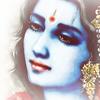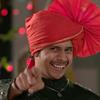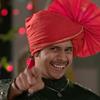Originally posted by: BrhannadaArmour
I am not qualified to say where the iconography appears first: in paintings, sculptures, oral tradition, or written texts in vernacular or classical languages.
Yasoda's daughter is mentioned at three places in Harivamsa (critical edition): first she is an incarnation of Nidra and deified as Kausiki; then Kamsa describes her worship as Vindhyavasini; then when Krsna returns from Pragjyotisa, we are informed that "the girl for whose sake Krsna killed Kamsa" grew up in the Vrsni family and she is Ekanamsa, holding hands with her two brothers.
This route of the story would've definitely been fascinating to read! In this version, Krishna probably wouldn't drift away from Nand-Yashoda as seen in most popular retellings (although, I guess some scriptures do make them reunite later-ish?).
The Tamil poem Cilappadhikaram portrays the worship of Onranpakuti (= Ekanamsa), referring to her as Pinnai (= Anuja) holding the hands of Mayavan (= Krsna) and Tammunon (= his elder brother). Here, she seems to be Krsna's lover although her name suggests that she is his sister.
This hand-holding iconography has a nice callback value to Puri-Jagannath idols. Also, I read that some traditions identify (Nap)Pinnai with Radha, so maybe that might be a contributing factor to the lover/sister confusion?
Here, I am just going on Pinnai/Nappinnai name similarity, I don't actually know Tamil well enough to decide if this counts. 😆
Pinnai evolved into the character of Nila, identified as the daughter of Yasoda's brother Kumbhaka. The myth of Krsna subduing seven bulls moved from the Onranpakuti dance into Nila's marriage in manuscripts of Harivamsa, and then Bhagavata-purana transferred it to Krsna's marriage to Satya Nagnajiti. Even later, Brahma-kanda of Garuda-purana tries to merge these three characters through the story that Krsna granted a girl's wish: "When you take birth as Krsna, I want to be with you from the very first day, and I want to marry you before anyone else." Although the present text of the story only tells us that miraculously Nila became one with Nagnajiti, and doesn't tell us anything about Yasoda's daughter, the allusion to a girl being with Krsna from the first day of his life can only refer to Yasoda's daughter being born on the same night.
See again Yashoda's brother appears in the story, as paralleled by the Ayan Ghosh/Radha dynamic that develops later in folklore. Also, the "be together from the first day" sounds like it's along the same lines as the story of Radha being born unable to see and only opening her eyes once Krishna gets close.
I find it incredible how so many of the mythological stories are interdependent. I also feel when we are reading translations/commentaries we tend to miss out on so many linguistic twists and turns, which tend to be oversimplified when read from someone else's perspective other than the original writer.
The tithi was navami by the time Yasoda's daughter was born. In some Jaina versions, Kamsa disfigures her nose and so she is called Ekanasa (single-nostril). The names Ekanasa and Navamika belong to two of the Dikkumari deities protecting the West in Jaina geography. In some Jaina versions, Satyabhama is Kamsa's sister and a contest for her marriage is the pretext that brings Krsna from vraja to Mathura, but I haven't found a story in which Krsna kills Kamsa for the sake of Ekanamsa as alluded by Harivamsa.
In Indian traditions also do we count tithi by midnight? 🥱
Kamsa just keeps getting worse with each new story I hear, the guy clearly needs to chill out a bit.
However, in this version, Satyabhama would be his aunt right? I would say that's icky, but Krishna clearly has a history with aunties, throughout folklore. 😆
In one of the Jataka stories, Ghata-pandita-Jataka, ten girls born to a slave-woman named Nandagopa are exchanged for ten boys born to her royal mistress Devagabbha, and it is Devagabbha's own firstborn daughter, Anjanadevi, who may correspond to Ekanamsa. Her brothers realize that they forgot to give her a share of their kingdom (the word "anamsa" does not appear in the story) and she is the sole survivor (eka) after her brothers Vasudeva, Baladeva, and the rest are killed.
Oof that's rough!
Krsna's people are identified as Gopa and Narayana when they fight in the Mahabharata War alongside Samsaptakas (from Trigarta) and Yavanas. Subhadra dresses as a gopalika to enter her marital home. Harivamsa introduces Vasudeva as a gopa. So, it's not that Krsna went from statesman to cowherd; rather, cows were the wealth that made his family equal to other royals, and the distinction between Mathura and vraja has gradually widened as the story is retold. (Not only figuratively but literally! In Harivamsa, Mathura and vraja appear to be on the same side of Yamuna; in Bhagavata-purana, Vasudeva has to cross the river.) The value of cattle for royalty is seen when Duryodhana goes for ghosayatra, when Susarman and Duryodhana conspire for gograhana (seizure of Virata's cattle), when Krsna seizes Bana's cattle for Satyabhama, and in royal characters' names like Govasana and Damaghosa.
That actually makes a lot of sense. It's interesting to see how they actually went the opposite way from what I was thinking.
An English translation of Harivamsa (critical edition) by Simon Brodbeck was published just a few years ago.
Thanks so much, I'll try to find a copy.
















comment:
p_commentcount